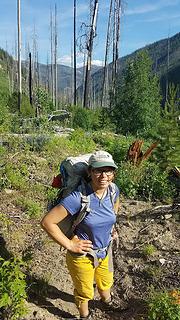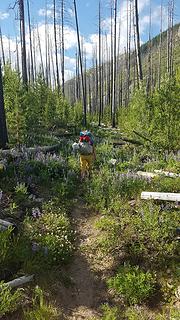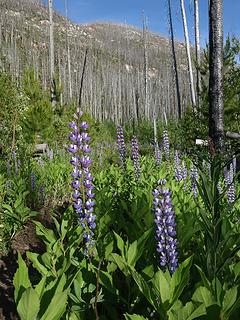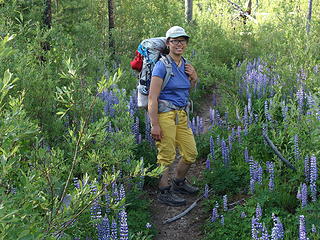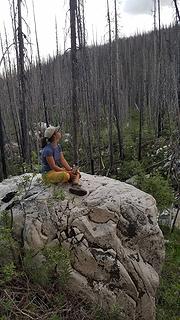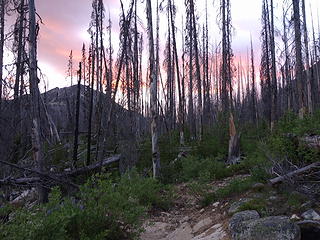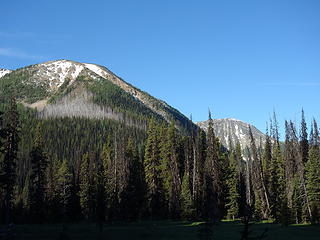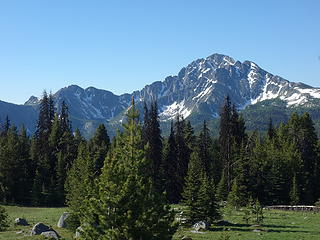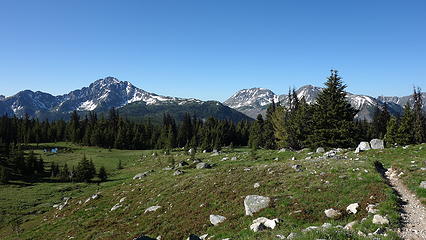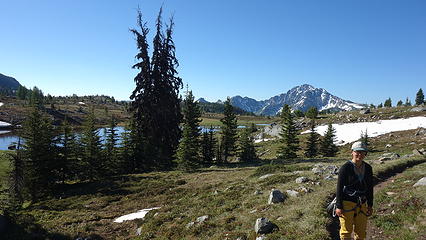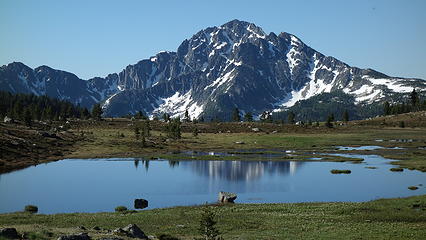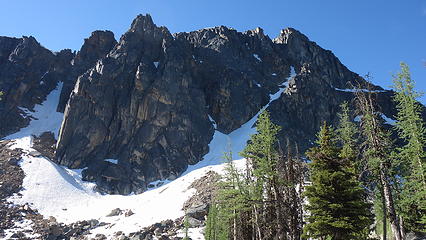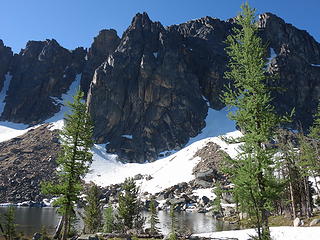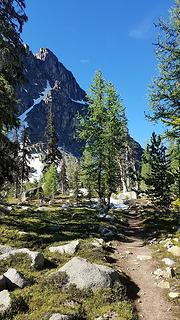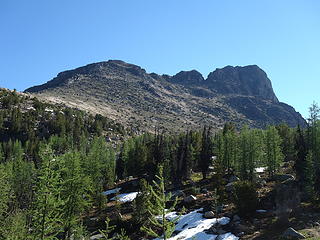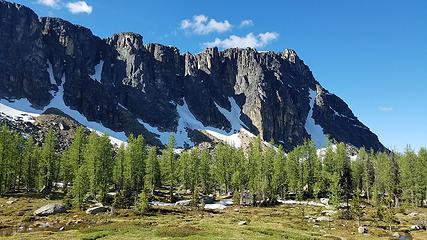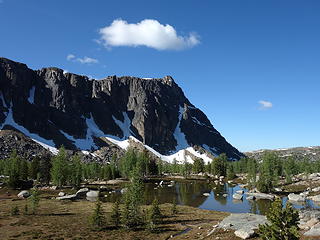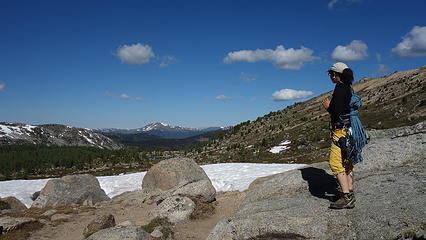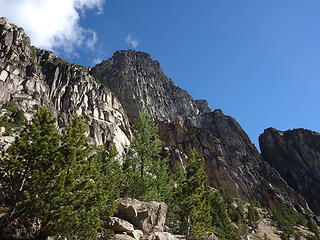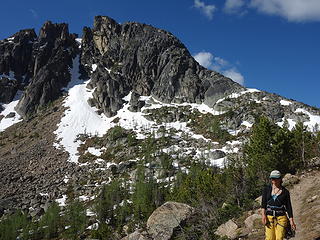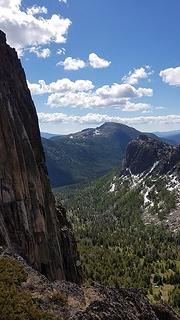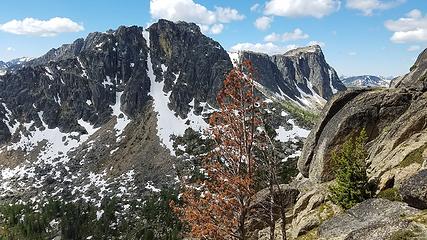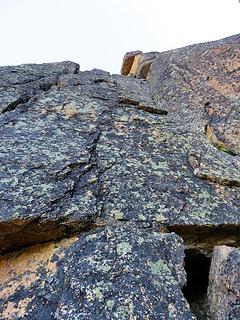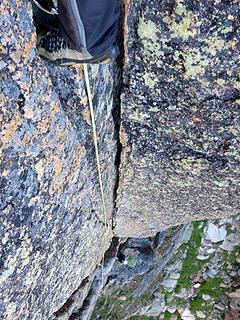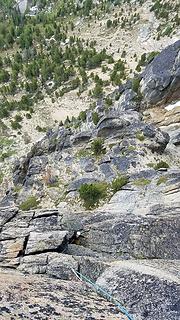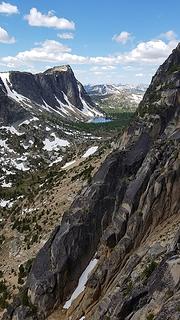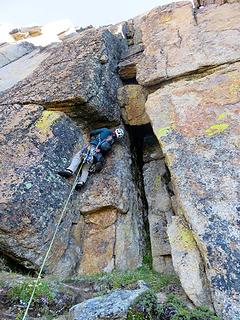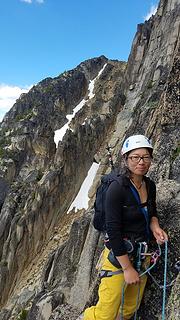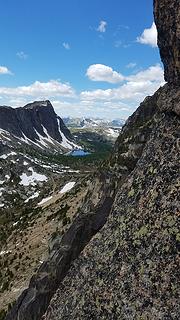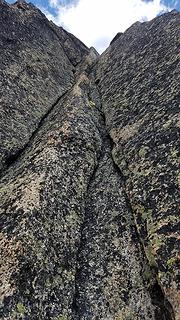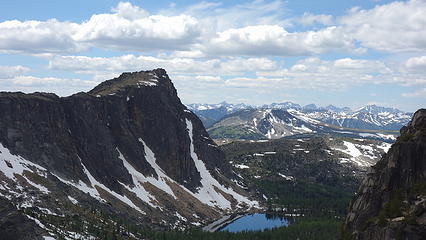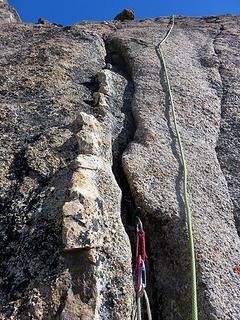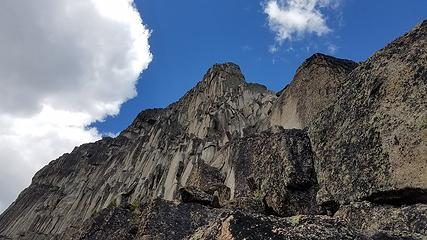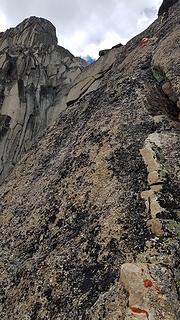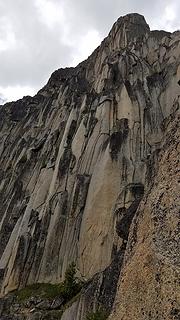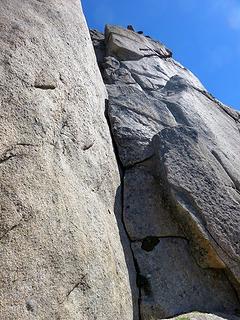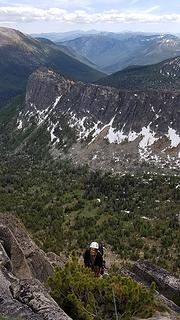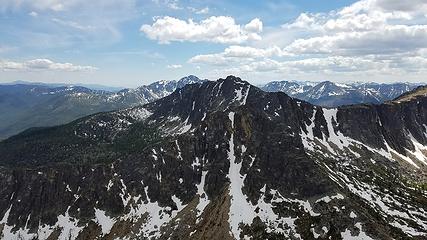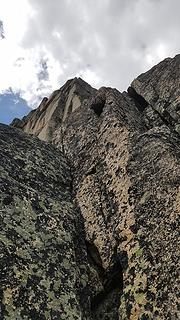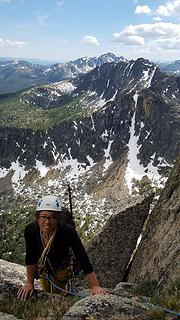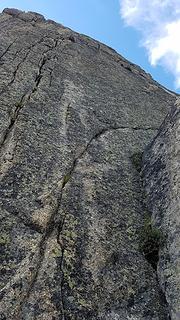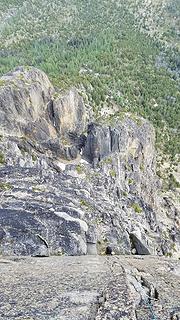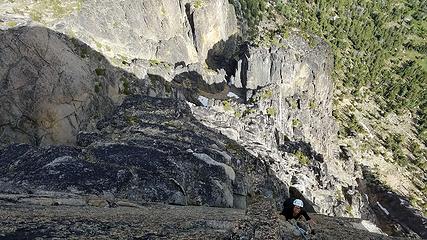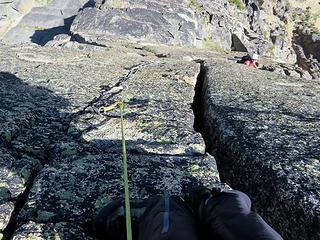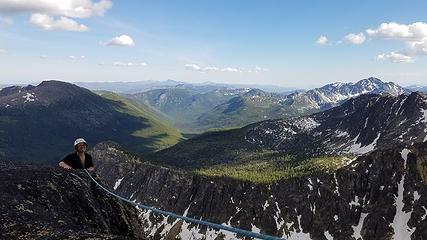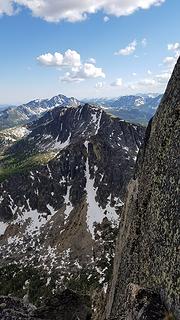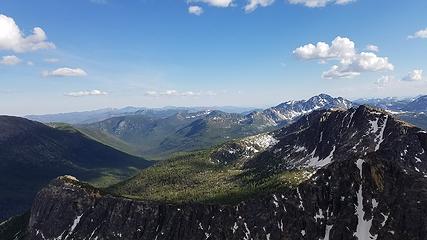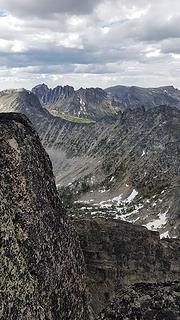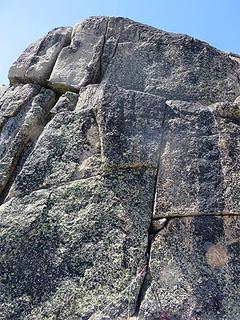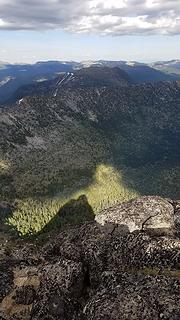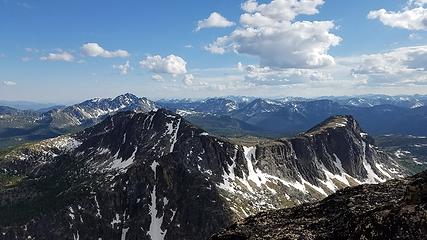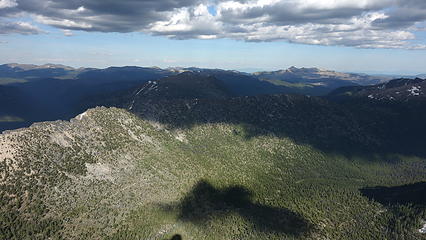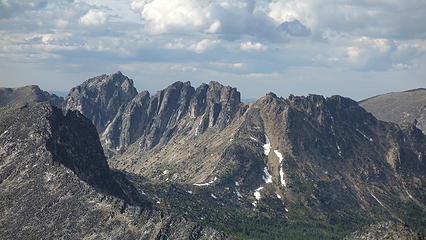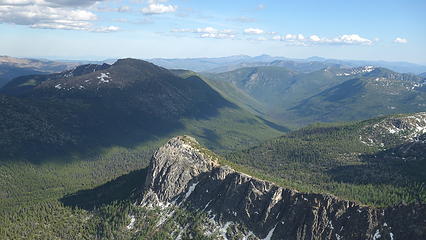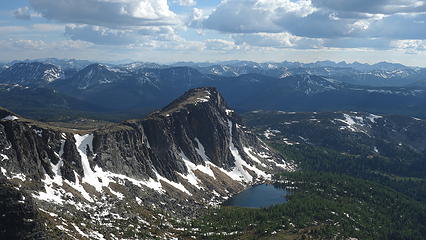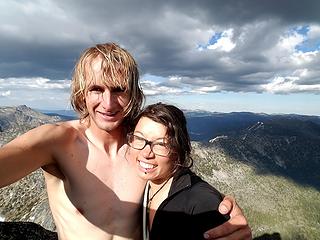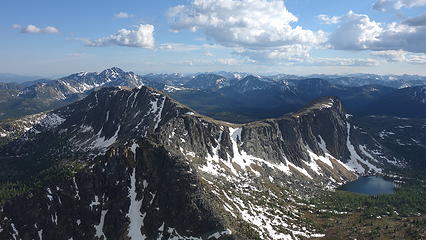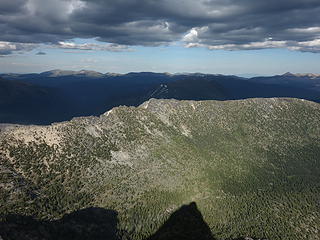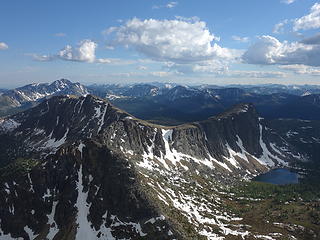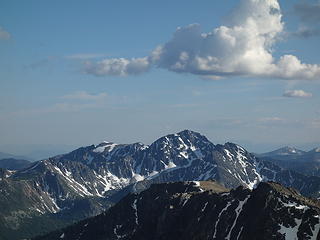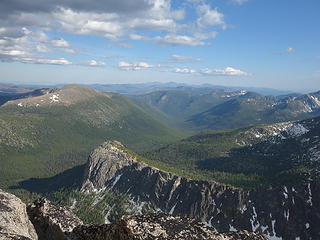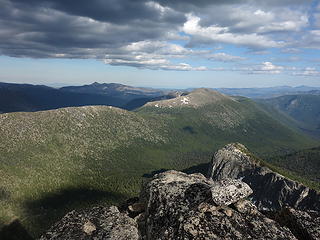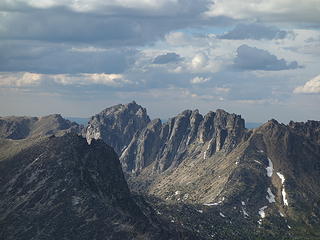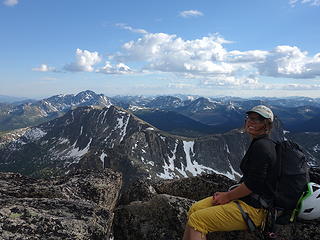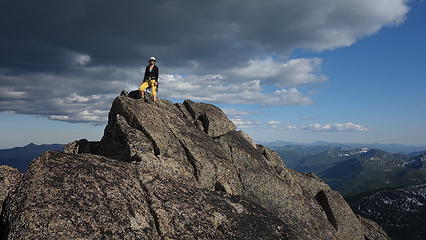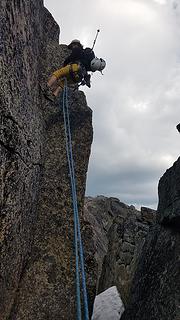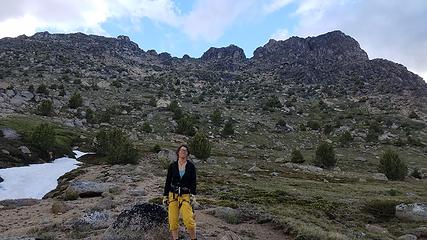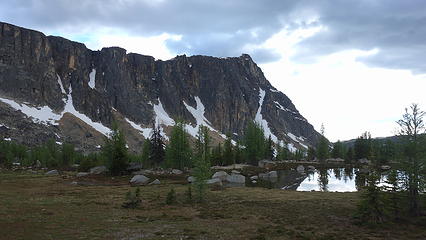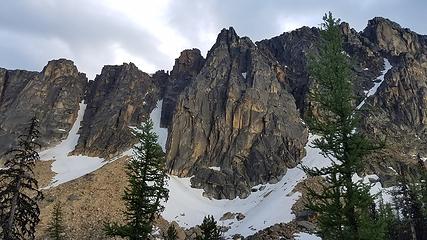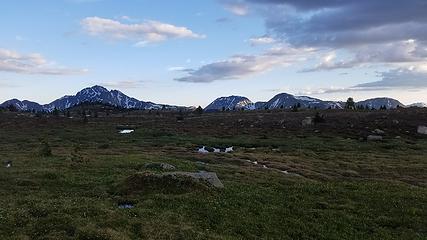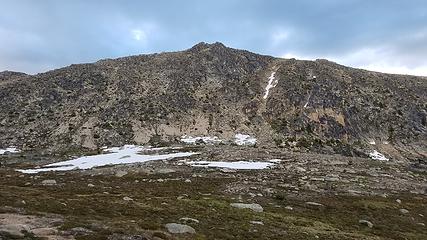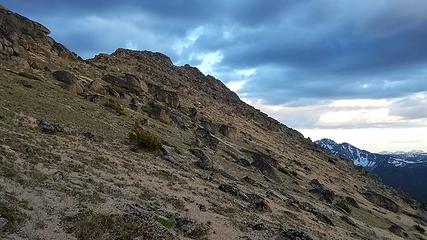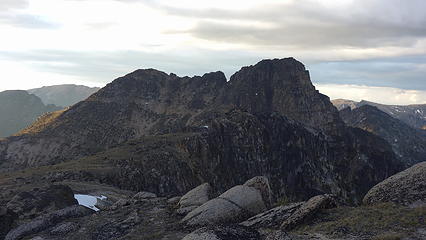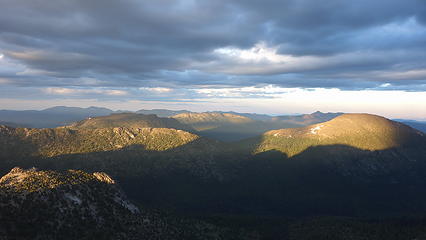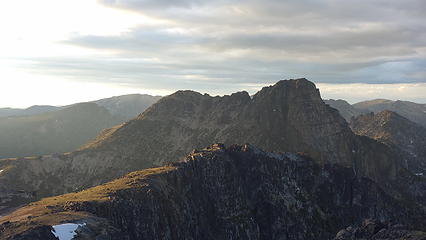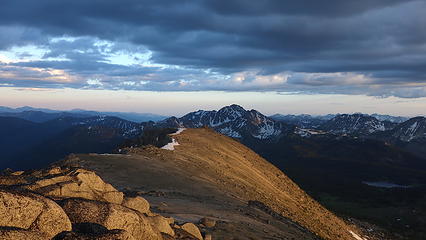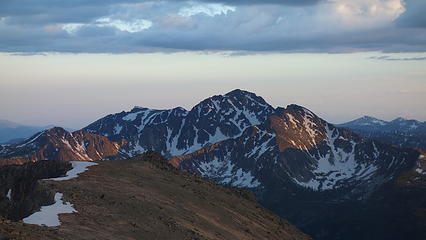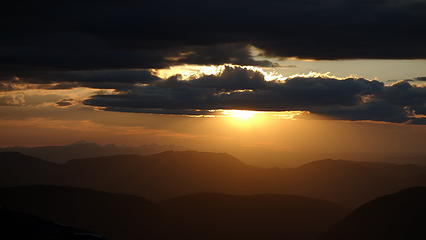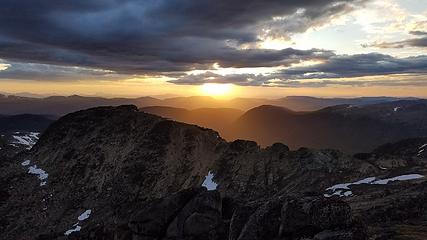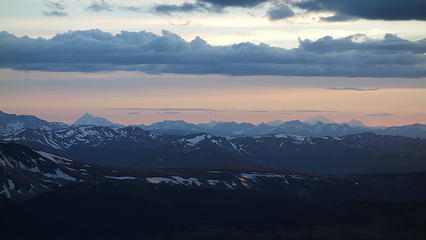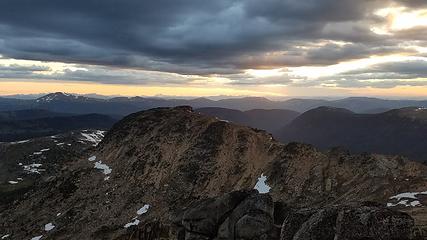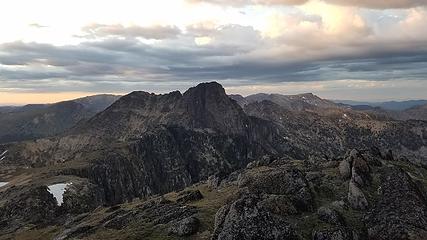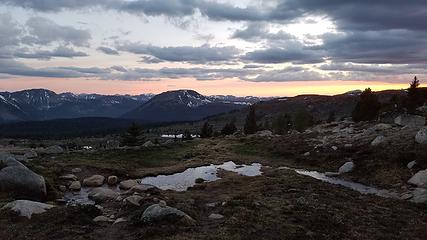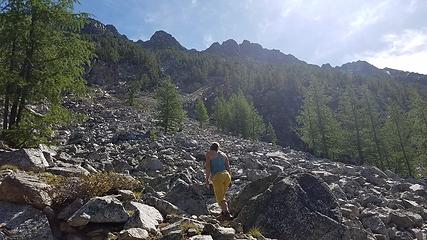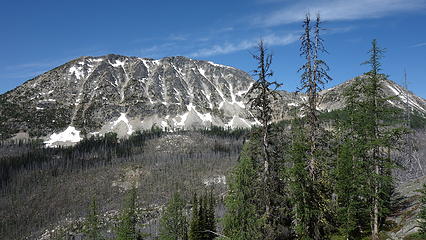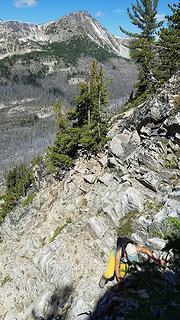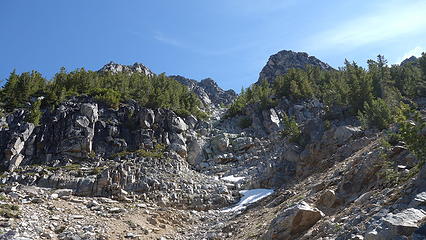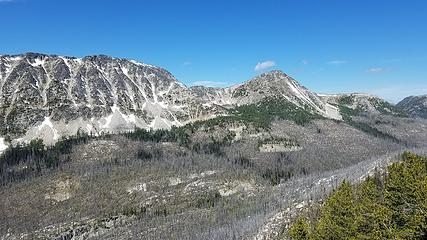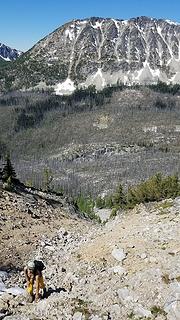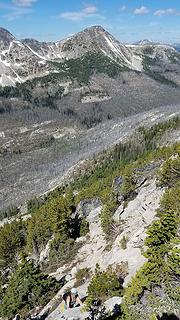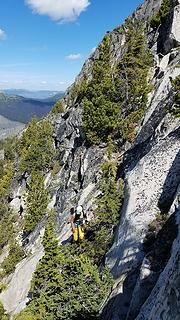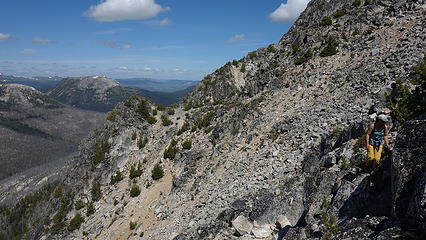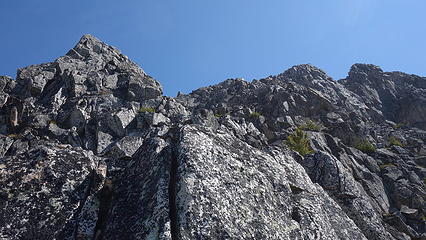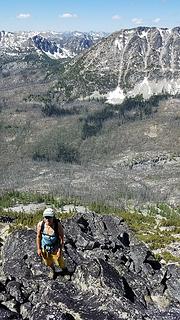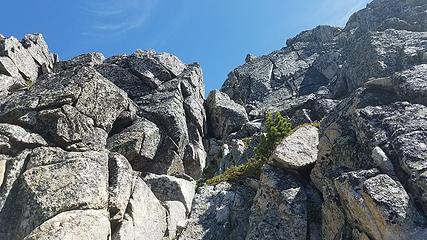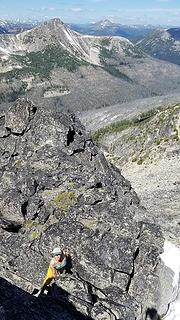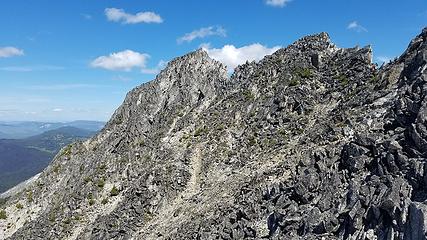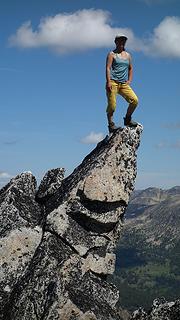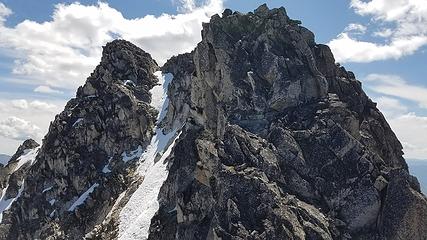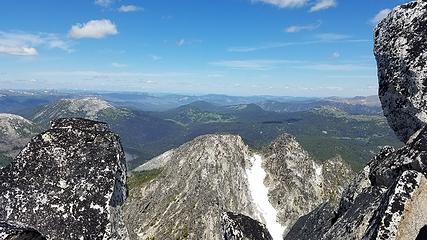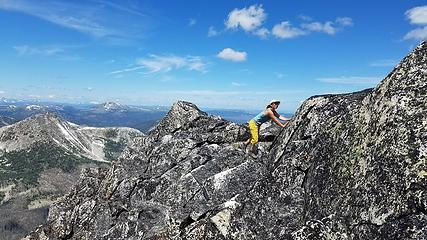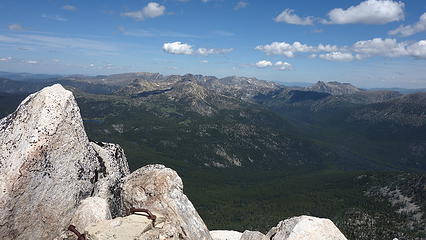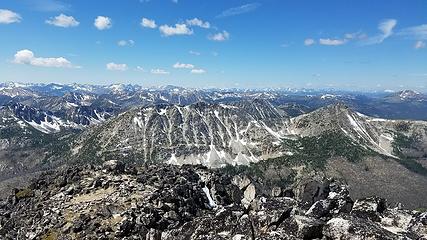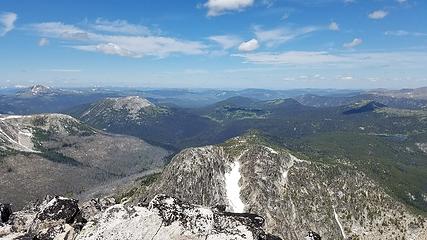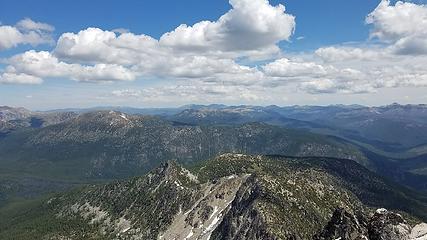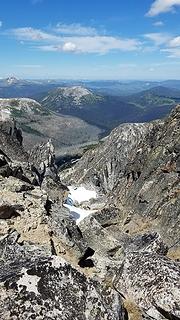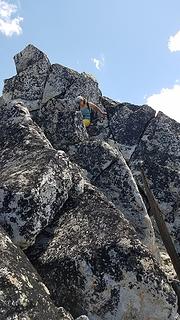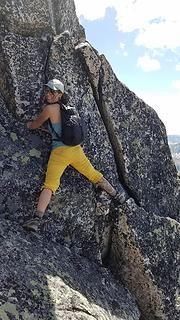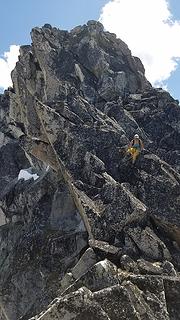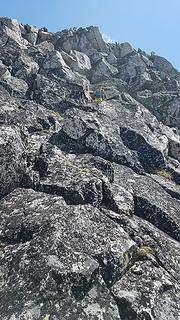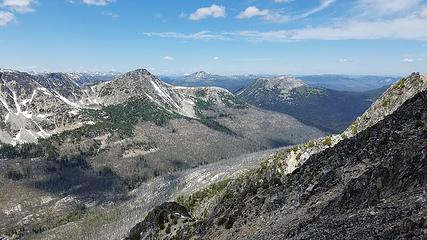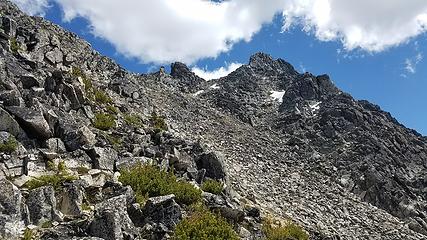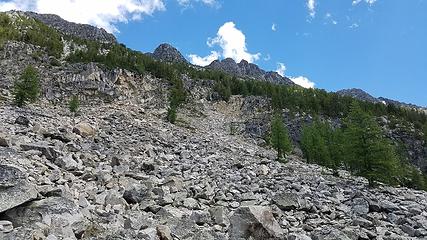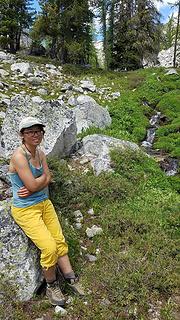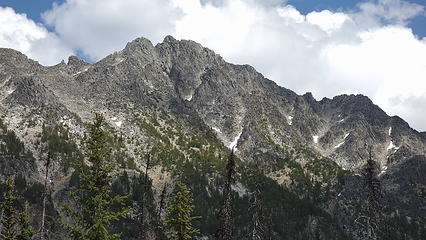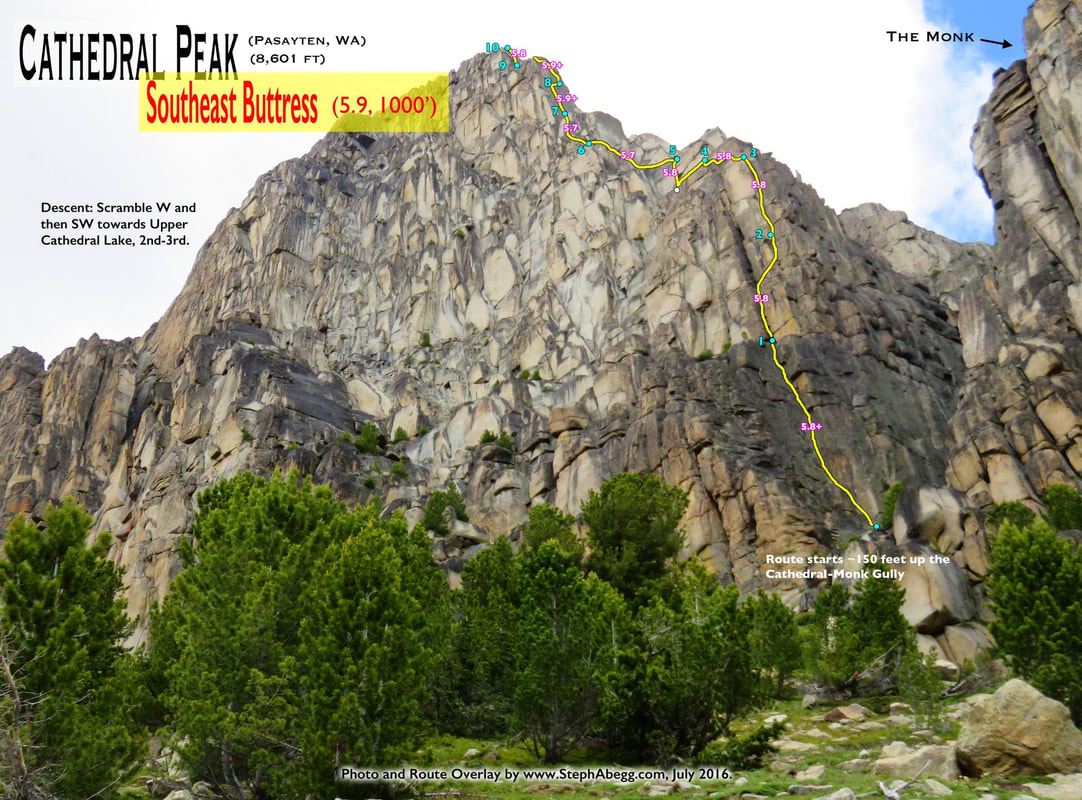Cathedral Peak - 8601' - SE Buttress Class 5.9
Ampitheater Mountain - 8358' - SW Slopes class 2
Remmel mountain - 8685' - West face Class 4
June 2017
As part of my quest to finish the Bulger peaks, I enlisted Elaine to join me to climb three remote peaks in the far northern stretches of the Pasayten Wilderness, which required a 20 mile approach up the Andrews Creek Trail to reach the peaks in the Remmel group. Having been wanting a break from so much snow, late June was still too early further west for some minimal snow ascents, so I figured it would be a perfect time for these peaks since they will probably be on fire within a month (they actually were on fire only 10 days after we were there). I was on a month-long leave from work in Edmonton, and Elaine also had some time to travel with me. After a quick visit to the grocery store in Winthrop, we headed out to the Andrews Creek trailhead, packed up our packs to be as light as possible, while still carrying rock pro and a 60m rope, and started the long walk to Andrews Pass. The bugs were out, and the sun was beating down on us as we hiked through many old burn areas. I informed Elaine that Cathedral Peak, the one we would be doing technical climbing on (SE Buttress) was just a one kilometer from the Canadian border, and she was wondering why she came all the way to the US just to walk back home to Canada haha. Actually, it is easier and much shorter to approach Cathedral Peak from Canada. Due to our late 2:30 pm start, we reached Andrews Pass shortly before it got dark and set up the tent right at the pass, 15 miles from the car.
The next morning we got an early start and continued hiking 3 more miles north along the trail to the junction with the Boundary Trail, which we then turned right and continues northeast a few more miles all the way to Cathedral Pass, passing Cathedral Lake on the way. There were just a few small snowfields remaining at the lake, which was a pleasant surprise compared to the many feet of snow still remaining around Rainy Pass. From the pass, we descended on the trail just a couple minutes then left the trail, veering sharply left and up loose talus towards the large deep gully separating Cathedral Peak from the Monk, a smaller rock tower just to the east. A little ways into the large gully, we reached the base of the famed SE buttress. This route was probably the best route I did on any of the Bulger peaks judging strictly by quality of rock, and featured 10 pitches of perfect granite crack climbing, something Elaine also really loved.
The SE Buttress I have described in detail below:
Pitch 1 - The first pitch involved a steep 5.8 crack that took 3" cams well. I remember being a little winded after topping out on the large ledge atop this long pitch. The final couple moves utilized a large corner that added to the variation. Mantle up onto the large ledge and set up the belay on a small tree.
Pitches 2/3 - The next two pitches, also sustained 5.8 were stellar near vertical hand cracks. The start of the 2nd pitch involved a deep chimney with a chockstone wedged inside, but quickly narrowed into a perfect crack system after climbing over a small overhang. A small ledge offered a nice belay stance atop the 2nd pitch, and the 3rd pitch was probably the most enjoyable on the route.
Pitch 4 - After the 3rd pitch, the steepness relented, and the 4th pitch consisted of an easier ascending leftward traverse over blocky terrain, but ended with a distinctive quartz dike cutting through an otherwise fairly featureless slab. Climbing this quartz dike is key to this part of the route (which felt more like 5.7). A very large ledge awaits you just above.
Pitch 5 - This pitch is where routefinding becomes very critical. Traverse left about 40 yards on the wide ledge to a distinctive right facing corner crack, with a featureless slab on the left. Climb this short 5.8 crack to another ledge. There are many variations here though.
Pitches 6/7 - This is the easiest portion of the route, and there are a number of variations for these 2 pitches, some 5.7, some a little harder. The goal is to work your way up and trending slightly left towards the base of the final headwall. We followed the path of least resistance, keeping the difficulty in the 5.5 range except for a short steep 5.7 crack that brought us right to the base of the headwall.
Pitches 8/9 - These two pitches climb the headwall, and can be combined if 5.9+ is well below your leading grade, however climbers near their limit will normally make a belay on a small ledge just enough for one person halfway up the headwall. A wide horizontal crack just above the ledge allows for bomber pieces to be placed for a solid anchor. For the second half of the headwall, there are two options. You can climb straight up continuing directly above the 8th pitch via an off-width crack, or traverse 5 feet right and climb a more enjoyable finger crack (which is what we did). Upon topping out on the headwall, there is a large tabletop ledge with lots of room to rest and set an anchor.
Pitch 10 - Just when we thought we were done, there is another stout, yet short 5.8 pitch to the summit. Go straight up the middle of the final face where a solid crack splits. Do not be tempted to walk out to the right as the rock deteriorates over there. Once above, it's a short easy scramble to the true summit!
We topped out a little later than we planned, and it was going to be cutting it close to also climb Ampitheater that afternoon, so we didn't stay too long on the summit, and began descending the standard route.
Descending the normal route went smoothly, and the coveted "leap of faith" proved to be merely a step over a deep crack. There was even a way to scramble around it if needed. We pretty quickly were back on class 2 scree and talus and made quick time descending back to the trail, where we took a decent break to eat.
It was nearing 6pm now, and we began walking fast back to Cathedral Lake, where we ran into a couple looking to climb the SE buttress the next day. We provided them with some beta, then went on our way, continuing around to the south side of Ampitheater Peak and following an unnamed trail into the basin to the SW of Ampitheater Peak. We stashed our climbing gear near the main trail, and I urged us to continue moving at a brisk pace up the class 1-2 terrain with no packs until we reached the summit. At about 8:30pm we topped out and were able to relax and watch the gorgeous sunset from the top. We made it up both peaks even after doing the technical route on Cathedral...that is a perfect day in the mountains if you ask me!
As the sun was setting, we still had to hike 6 miles back to our camp at Andrews Pass. Upon returning to our gear cache, Elaine realized she had left her rock climbing shoes somewhere along the descent of Cathedral, likely where we met the trail and took a break. So We agreed to split up, and I would return back up past Cathedral Lake nearly to the pass to grab her shoes and she would continue down. It got completely dark just as I got back to the lake, and luckily, I remembered exactly where we had met the trail because of a distinctive boulder. So I was easily able to locate the shoes and make my way quickly back, and make the long 6 miles back to Andrews Pass. The final couple miles, as midnight came, and passed, I was getting quite delirious and losing balance both from being so tired and also disoriented due to the darkness. Eventually, after making sure I went the correct way for all the trail junctions, I made it back to the pass, where Elaine had reached just 10 minutes before I did. We didn't even cook dinner and went straight to sleep.
The next morning, we slept in a little, and by 8:30 or so, we started straight up the west slopes of Remmel. We decided to climb the west face of Remmel since it was directly above our camp, and would make for a short, yet steep ascent, with some unknown scrambling up above. We picked our way up gullies, ribs and talus slopes aiming generally towards the summit, with the scrambling staying at class 2 and 3 with the exception of a very exposed traverse around a small cliff band 20 feet or so below the summit. This went at exposed class 4 but still very manageable. The view west just across the pass of Andrew Peak was nice as well. Once on the summit, which we reached after only a couple hours from camp, we took our time to relax. I noticed the class 1 trail coming from the east side and was happy to do a more adventurous route on Remmel as well. Most people turn these peaks into long slogs and never end up enjoying them, however the Remmel group ended up one of the most memorable Bulger Peak groups I did.
We quickly retraced our steps down to camp, and I noticed a note in my tent informing us we had pitched the tent directly under a tree that was halfway fallen over, and only held up by another, smaller tree...doh! We stayed 2 nights under that precariously perched tree. Lesson learned lol.
We started the long walk our around noon, and broke the hike up in one hour increments. Since I walk faster, I would go for one hour, then wait and we would take a small break ad repeat. Near the trailhead a small river allowed us to bathe and clean ourselves a bit before heading to mexican food in Winthrop for a well earned meal.
